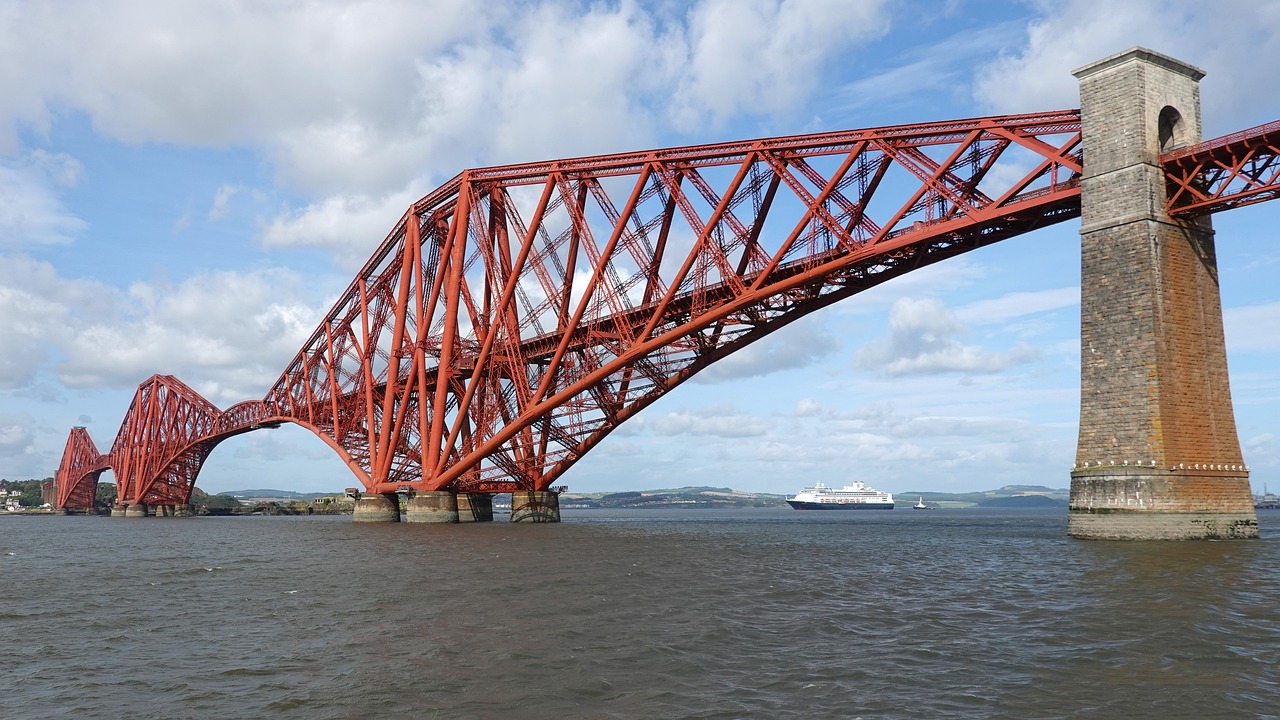The iconic Forth Bridge in Scotland holds the distinction of being the oldest major steel bridge still in use today. When it opened in 1890, it was the longest steel cantilever bridge in the world and a marvel of Victorian engineering. Spanning over 1.5 miles (2.5 km) across the Firth of Forth, the bridge remains one of Scotland’s most recognizable landmarks and a UNESCO World Heritage Site.
A Vital River Crossing
The Forth Bridge connects Edinburgh on the south bank of the Firth of Forth with Fife to the north. Prior to its construction, the only ways to cross the estuary were by ferry or by a rail bridge completed in 1851. By the late 1800s, the old bridge was struggling to cope with increased traffic and had become a major bottleneck.
With industrialization and population growth in the region, it became imperative to build a new bridge with higher capacity and improved reliability. In 1873, the North British Railway Company organized a design competition to find the most suitable design for a new bridge over the treacherous waters of the Firth of Forth.
Pioneering Cantilever Design
The winning concept was a novel cantilever bridge design submitted by English engineers Sir John Fowler and Sir Benjamin Baker. Cantilever bridges use projecting arms extending from vertical towers to support the bridge deck from above. This avoids the need for piers sunk into the riverbed, ideal for bridging the deep and fast-flowing tidal waters of the Firth of Forth.
The Forth Bridge’s two main spans of 1,700 feet (517 meters) were record-breaking at the time and pushed the boundaries of cantilever design. The three double-tower design gave the bridge an iconic structural silhouette visible for miles around.
Challenges of Constructing the Bridge
Constructing the Forth Bridge presented enormous challenges. To reach the bedrock under the river, the workers had to dig down 55 feet (17 meters) to lay foundations. Caissons or chambers were sunk into the riverbed and filled with concrete to create a stable base.
Huge cantilever arms were built out from the towers using a complex scaffolding system. Teams of skilled ironworkers balanced precariously along the arms to bolt sections into place. Tragically, 57 workers lost their lives during 8 years of dangerous construction work.
When finished, the Forth Bridge contained over 53,000 tons of steel – a staggering quantity at the time. Huge railway lifting cranes were specially constructed to move the enormous steel sections into position.
Later Additions and Upgrades
The bridge first opened for rail traffic in 1890 and was formally opened by the Prince of Wales in March 1890. At 4,787 feet (1,459 meters) long, it easily surpassed the previous record for longest cantilever bridge.
Further expansion occurred in 1925 with the opening of a double-track rail bridge running alongside the original single track. This increased capacity met rising traffic demands. Between 1958 to 1959, truss sidespans were added to transform the bridge’s appearance.
In the late 20th century, engineers implemented various reinforcement and renovation projects. Steelwork repairs, new paint coatings, and structural resurfacing ensured the bridge remained fit for service into its second century.
World Heritage Site Status
In 2015, UNESCO designated the Forth Bridge as a World Heritage Site. This recognized its status as an icon of Scottish engineering and a masterpiece of Victorian ingenuity. It is only the sixth Scottish site to receive this prestigious honor.
The bridge remains a Grade-A listed structure today. Ongoing management and conservation efforts aim to preserve its unique heritage and engineering legacy well into the future.
Later Bridge Developments
While the Forth Bridge remained the longest steel cantilever bridge for 17 years, rapid 20th century developments soon eclipsed its records. Other famous cantilever bridges include:
- The Quebec Bridge in Canada (1917) with an 1,800 foot (549 meter) span.
- The Amazonas Bridge in Brazil (1939) spanning 3,300 feet (1,006 meters).
- The Minato Bridge in Japan (1973) with a main span of 2,612 feet (796 meters).
Although the Forth Bridge no longer holds span records, it retains its status as a pioneering Victorian engineering landmark. Its distinctive industrial architecture has made it an iconic Scottish landmark recognized around the world.
Visiting the Forth Bridge
The Forth Bridge is easy to visit on a trip to Edinburgh or central Scotland. Trains and buses from Edinburgh stop regularly at nearby towns with great views such as North Queensferry. Boat cruises passing under the bridge are also a popular way to admire its imposing structure.
For stunning panoramic views, walk across the bridge on the pedestrian walkway attached to the northern side. Interpretation boards highlight key facts and figures about the bridge’s design and history.
Nearby visitor attractions include the Forth Bridges Visitor Centre and the Railway Museum in the old Hawes Inn at South Queensferry. These provide interactive displays and photography exhibitions documenting the bridge’s fascinating story.
Legacy of an Engineering Marvel
The scale and complexity of the Forth Bridge project pushed contemporary Victorian engineering to its limits. Its construction demanded pioneering use of cantilever technology and precision design on an unprecedented scale.
The bridge stands today as testament to the vision, ingenuity and determination of its Victorian designers and builders. Its distinctive industrial silhouette remains a recognizable symbol of Scotland and a powerful emblem of rail transport heritage.

